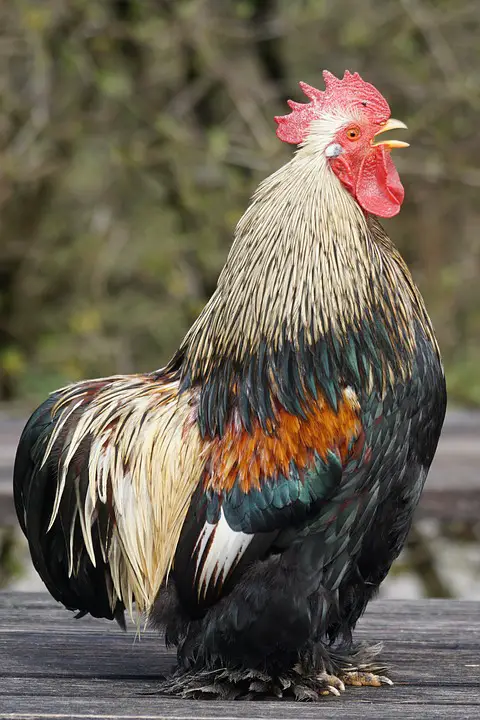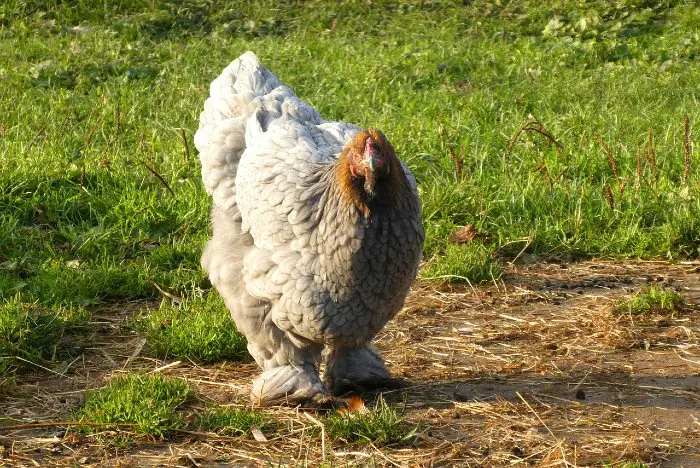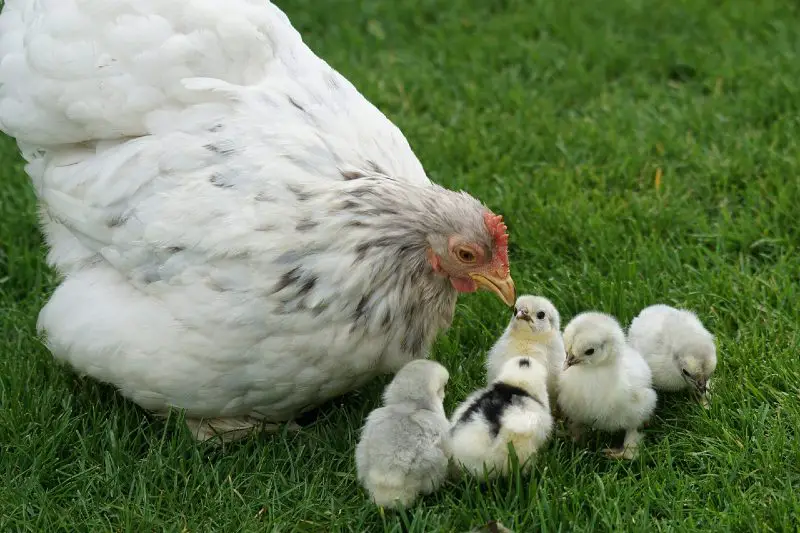When most chicken breeds are developed, they are designed for a practical purpose. This could be chicken for eggs. It could be chicken for meat. It could be for feathers. The Cochin Chicken is different, though, especially the bantam Cochin chicken.
While it can be used for all of those purposes, today, the whole reason that this chicken exists is because of chicken shows.
Let’s take a little look at what the Cochin Chicken brings to the table… quite literally, in some cases.
Cochin Chicken Facts at a Glance
| Eggs | 140 per year |
| Egg Color | Brown |
| Use | Meat + Ornamental |
| Comb Type | Single Comb |
| Weight | Male: Standard: 11 lb (5 kg) Bantam: 32 oz (910 g) Female: Standard: 8.5 lb (3.9 kg) Bantam: 28 oz (795 g) |
| Country of origin | Asia |
Bantam and Standard Cochin Chicken Origin
The Cochin Chicken is an older breed and it has been around since the middle of the 1800s. feather-legged chickens
The bird was developed in Vietnam, although, of course, it was not Vietnam then. It was regarded as a French territory. The name comes from the Cochin-china region of southern Vietnam.
The thing with the Cochin Chicken at the time is that it was meant to be a utility chicken. It was meant to lay eggs. The chicken breed back then didn’t look anything like the chicken breed that we all know and love today.
Those gorgeous good-looks were created by show breeders looking to create the ultimate ‘beautiful’ chicken.

The Cochin breed was brought over to England and given as a present to the monarchy.
Obviously, this triggered the upper class in the country to want to pick up the breed. It was exceedingly popular, but it was out of the price range of the majority of the country.
Especially the bantam Cochin chicken. A single chicken back then could sell for as much as a house. It is no wonder that people wanted to breed them.
That is pretty much the only information we have about the early history of the Cochin Chicken.
We really do not have much of an idea of how the chicken evolved to become the stunning looking chicken that we all know and love today.
Obviously, it was down to a lot of selective breeding, but no one has a clue what the breeds were. It is highly unlikely that the chicken breed we have today is 100% the same chicken stock as the ones that were imported over from the French territory close to 200-years ago.
Do You Want Big Beautiful Eggs?
Then you must check this ORGANIC & NON-GMO feed. Our hens lay jumbo eggs now and they love this feed! You can check it right here on Amazon.
Bantam Cochin
If you are from the UK, then there is no Bantam Cochin chicken there. Yes, the bantam version is not recognized in the UK. However, in the US the large and the bantam Cochin were recognized back in the 1874.
Unlike the large Cochin which is one of the friendliest breed in the world, you are encouraged to steer clear of the Bantam Cochin. That is a ridiculously aggressive chicken breed, for some reason.
The Look of the Chicken
The Cochin Chicken looks absolutely stunning. The second you lay your eyes on it, you will realize why it is such a loved chicken in the world of shows.
The feathers on the Cochin Chicken are so distinctive. They have a lot of them, and the colors and patterning are incredibly eye-catching.
The feathers pretty much cover their entire body, and this means all the way down to the feet. This makes the Cochin one of the 8 feather legged chicken breeds recognized by APA.

They are a pretty large chicken breed if you took away the feathers of the chicken.
Although, as you are about to discover, you probably would not want to be raising one of these chickens as a meat breed. They are simply not good for that at all!
The feet and skin are yellow. Although, the rest of the features on the chicken are pretty standard. It is clear that the breeders behind this chicken took a lot more time trying to produce a chicken with fantastic plumage as opposed to anything else.
Cochin Chicken Colors and Recognized Variety
This is a list of all the recognized varieties and colors of the Cochin chicken:
- Barred
- Black Cochin
- Blue
- Brown
- Buff
- Golden Laced
- Partridge
- Silver Laced
- White
For a more comprehensive analysis of each color variation, please see our Cochin Chicken Color Chart.
Cochin Chicken Meat
The Cochin chicken breed can grow to a whopping 11-12 lbs in size. So, we know what you may be thinking; this must be a brilliant meat chicken breed, right?
Well, no. Not exactly. Obviously, the Cochin chicken is going to be able to be eaten just like any other chicken breed out there, it just really isn’t suited to the purpose.
Commercial chicken farmers would never touch the Cochin chicken if they wanted a meat breed. It grows ridiculously slow. In fact, it can take close to 1.5-years to be fully grown.
No commercial chicken farmer wants to have their chickens kicking around for this long before they can be slaughtered. After all, that is a lot of food that the chicken is going to need to eat! It may be fine for backyard chicken breeders, but even then, we do not think the chicken is going to be great for that.
The problem with the Cochin chicken is that it doesn’t actually taste all that good. The meat is a little bit tough.
Obviously, it is going to be identifiable as a chicken, but the taste just isn’t good. There are far better chickens if you want something to eat, and most of them are going to grow a lot faster as a result.
Cochin Chicken Eggs
When the original breed was developed, this chicken was an egg-layer. You couldn’t really afford to have a chicken back then if it wasn’t productive. Yeah. The breed is beautiful to look at, but owners wanted to get some use out of it.
You can’t just go around looking pretty. Not if you are meant to be a farm animal.

The problem is that as the chicken got better looking (i.e. as the breed was developed), the egg-laying capabilities started to be reduced.
Nowadays, the chicken can lay some beautiful large, brown eggs. However, it doesn’t really do them in any sort of quantity. You are going to be able to get a few of them a week, at the most. So, you can expect to get up to 140 eggs per year from a Cochin hen.
Thankfully, the Cochin Chicken does excel in some areas when it comes to egg-laying. This is a chicken that has some beautiful, thick plumage. This means that it is more than capable of being able to keep itself warm during the colder months of the year. This makes them one of the best cold hardy chicken breeds.
This means that unlike some other breeds, the chicken continues to produce, even if the weather starts to get a little bit colder. If you have two to three of these chickens, then they could feasibly provide enough eggs a week to feed a couple.
Assuming you do not eat that many eggs each day. We think that the chickens need a bit too much food to maintain a ton of these purely for winter eggs. There are better breeds out there for that.
As a Show Chicken
As we have said several times before; the Cochin chicken is designed to be a show chicken. We suppose it could also be an ornamental chicken breed too.
However, the majority of the people that are breeding these chickens are going to be doing so with the sole purpose of taking them to chicken shows.
Although, to be honest, if you are planning to just pick up a couple of these chickens, we doubt they are going to be ‘show ready’ chickens, unless you are willing to part with a whopping amount of cash for the breed.
Is the Cochin Chicken for your Backyard Flock?

The Cochin chicken is a great family chicken. Despite the size, this is one of the friendliest chickens that you are ever going to meet.
This chicken is one that loves to explore, so it would be great if it had a larger chicken run that it can run around in. Due to the size, it is going to love getting protein from the various insects kicking about on the ground too.
The great thing about this chicken is that it is absolutely awful at flying. Because some chickens can fly very good. But, the large size means that it isn’t really going to get anywhere, even if it tried.
This means that you do not need to worry about your chickens escaping from anywhere. They will just run around, and that it is absolutely brilliant!
The Cochin is an excellent broody breed, which means it has very good mothering abilities, even for turkey and duck eggs!
Care Tips for the Cochin Chicken
As we have said several times, the plumage of this chicken breed is very thick. This means that during the warmer months of the year, your chicken is going to need to have access to a lot of shade and water.
Honestly, this is not a chicken breed that we would recommend for those that live in areas that get drastically hot. The chicken may be able to cope, but it is going to be suffering a lot.
Of course, the thick plumage does mean that the chicken is going to be amazing in colder locations.
Many people have noted that this is a chicken that loves to eat a lot. A lot. This means that you may need to provide greater control over their portions than you would with other chicken breeds. So, do make sure that you keep an eye on the weight of your Cochin chickens.
If you see that they are getting a little bit on the chunkier side, then you may want to reduce their food intake. Obviously, the last thing you want to have happen is to drive your chicken to an early death.
Other than this, there are not really going to be that many issues when it comes to raising your chickens. This means that you can just raise them like normal.
Make sure that you give them a decent diet. Make sure that you regularly check their overall health. If you can, then this ends up being one of the larger chicken breeds that can live a decent amount of time.


Pingback: Rhode Island Red Chicken - Facts You Didn't Know About & More
Pingback: The 8 Best Cold Hardy Chicken Breeds | ChickenMag